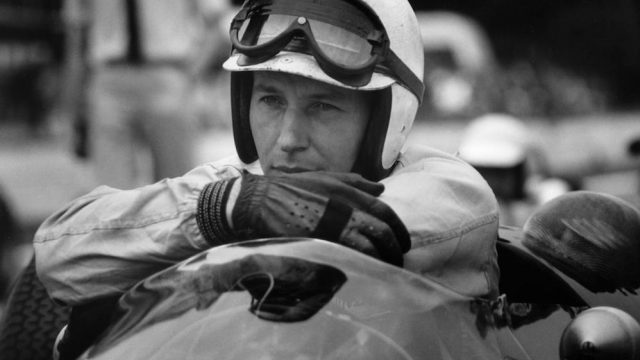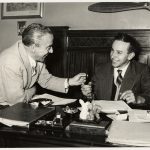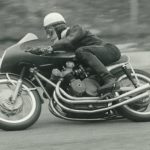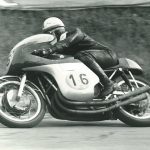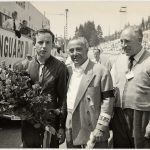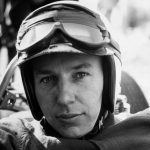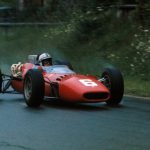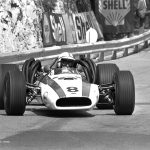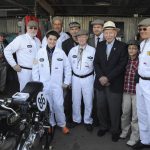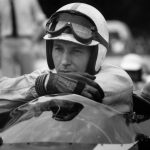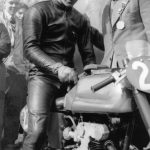Both motorcycle and car worlds are very much the poorer for his leaving us
Englishman John Surtees, who passed away in London on March 10 from respiratory failure just a month after his 83rd birthday, was the only man to be crowned World champion on both two wheels and four. Before winning the 1964 Formula 1 World Championship for Enzo Ferrari, he won seven motorcycle World titles for MV Agusta – another Italian race team run by a single-minded autocrat, Count Domenico Agusta.
Born in 1934 at Tatsfield, Surrey, John grew up working in the South London motorcycle shop owned by his father Jack, a former bus driver turned sidecar racer with whom 14-year old John made his competition debut in 1948 by passengering his dad to victory on his racing three-wheeler, only to be disqualified for being under age! On leaving school at 15, he began competing in grass track races at nearby Brands Hatch, but soon graduated to road racing after starting an apprenticeship in 1950 at the Vincent motorcycle factory at Stevenage, for which his father was a dealer. Later that season, on a 500cc Vincent Grey Flash he’d prepared himself, John Surtees recorded his first race victory at Aberdare Park in South Wales. By 1951 John was winning regularly, and hit the headlines for the first time by giving World champion Geoff Duke’s factory twin-cam Norton a hard time on his pushrod single at a major Thruxton race meeting that year.
During the early 1950s John Surtees established himself as one of Britain’s future two-wheeled stars, graduating from the Vincent in 1952 to a 500cc Manx Norton on which he competed that year in his first World Championship race, finishing sixth in the Ulster GP. In 1953 John made his Isle of Man TT debut, for which he’d been loaned a pair of factory bikes by Norton’s race chief Joe Craig. But having already committed to racing it before the Norton offer came along, he felt obliged to also ride Dr.Joe Ehrlich’s works 125cc EMC two-stroke, only to crash it in practice when the forks collapsed, leaving him with a broken wrist. Craig refused to forgive him for this until 1955, so in 1954 John raced a pair of 350/500cc customer Nortons he’d purchased himself to repeated success. He made his proper TT debut on these bikes, finishing 11th in the 350cc Junior race and 15th in the 500cc Senior, improving to 4th in the Junior TT the following year. Surtees also became British 250cc champion in 1954 after winning 15 races out of 17 starts on the unique REG dohc parallel-twin entirely created after hours in his home workshop by businessman Bob Geeson.

In 1955, Craig finally gave Surtees his first works rides aboard the factory Nortons in what would be the British manufacturer’s final season of racing its now outclassed singles. That year John won 69 out of the 75 races he started in Britain, and also began competing regularly on the Continent. But it was on an NSU Sportmax that he recorded his first ever Grand Prix victory, winning the 250cc Ulster GP at Dundrod. With Norton’s end-of-season retirement from racing imminent, John finished off the year by twice beating reigning 500cc World champion Geoff Duke on the four-cylinder Gilera at Silverstone and then Brands Hatch, results which with Norton’s retirement left Gilera itself as well as Moto Guzzi and BMW (for whom he’d ridden in the German GP on an RS500 Boxer) pursuing John’s signature for the coming season.
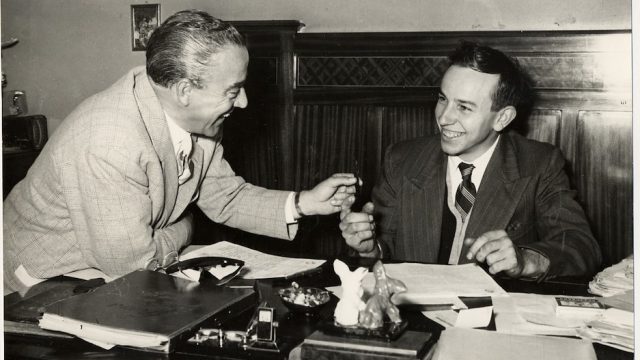
But instead, in 1956 John Surtees began a five-year association with MV Agusta – although only after Count Domenico Agusta’s elderly mother had inspected him to decide whether she liked the look of him, and had given her approval! Once admitted to the Agusta racing family, John won his first seven races on the Italian bikes in early-season British national races, before winning the Senior TT in the Isle of Man, his debut World Championship Grand Prix race aboard the 500cc four-cylinder MV, thus also scoring his first-ever TT victory. Altogether, John Surtees competed in 15 IoM TT races over a seven-year period, finishing in all of them except the 1956 Junior, with six victories. He won again at Assen on his Dutch TT debut, and made it a hat-trick of victories the following week at Spa-Francorchamps in Belgium, to establish an unassailable lead in the 1956 500cc World Championship. Surtees thus won his first of seven World crowns at the age of just 22 despite suffering a broken arm in a German GP crash, albeit in the absence of reigning champion Geoff Duke. He’d effectively been banned from defending his title by a six-month FIM suspension in return for supporting the privateer riders’ strike for reasonable start expenses at the 1955 Dutch TT.
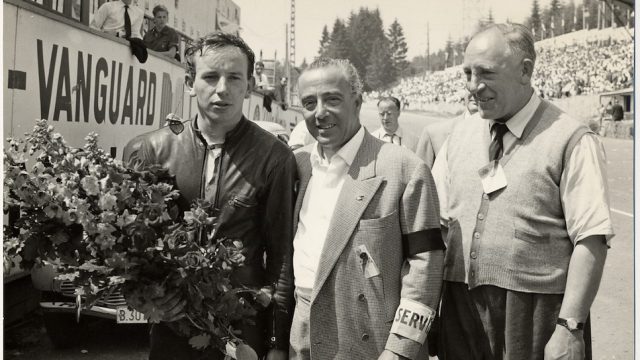
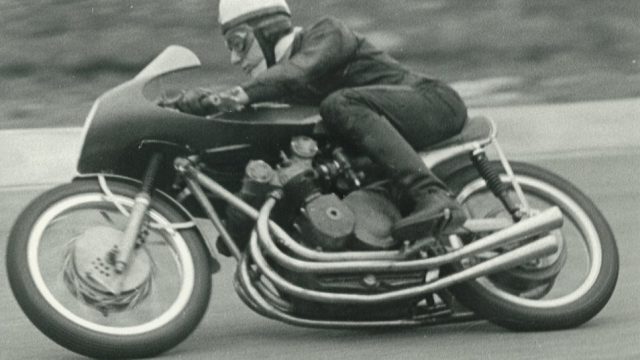
In 1957 John Surtees overcame any after-effects from the broken arm to win the season-opening Spanish GP in Barcelona. But that year’s MV Agustas were no match for the Gileras, and Surtees battled to finish third behind these in the 500cc championship, winning just once at Assen, and fifth in the 350cc series behind the all-conquering Moto Guzzi singles, and the pair of DKW two-stroke triples. This led him to urge Count Agusta to improve engine reliability and the four-cylinder bikes’ handling – especially with the full ‘dustbin’ streamlining that was by then universal. “The problem was that MV Agusta was a sideline from the Count’s aviation business,” John once told me, “and that meant their knowledge of aerodynamics was directed towards gaining lift, whereas on a motorcycle you needed quite the opposite! Moto Guzzi had their own wind tunnel, and were much more capable of designing motorcycle streamlining that was stable at high speed.” This led John to envisage leaving MV Agusta for Moto Guzzi, to the extent of agreeing a test ride on the firm’s increasingly competitive 500cc V8. But just before setting a date for this – which would surely have finished his chances of remaining with MV Agusta – on September 15, 1957 Guzzi announced it was joining Gilera and 125/250cc double World champions Mondial in withdrawing from racing.
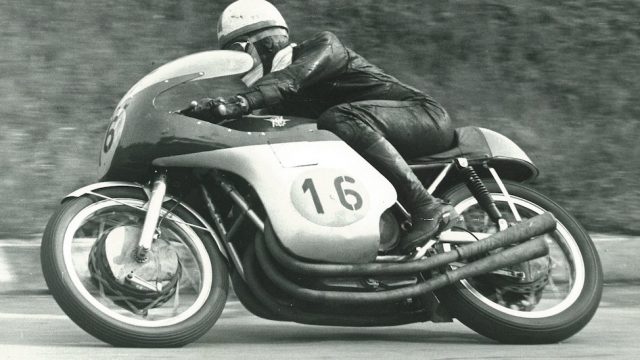
MV Agusta had originally agreed to join its three fellow-Italian companies in retirement, but Count Agusta thought better of it, thus opening the door to his bikes’ successive GP race victories against privateer competition mounted on aging British singles, and an uninterrupted run of World titles for his four-cylinder red and silver ‘fire engines’. John Surtees was a beneficiary of this, winning a hat-trick of Championships in 1958-60 in both 350/500cc classes by scoring victory in 32 out of 39 races, while also becoming the first man to win the Senior TT three years in a row. He won every GP race he started in 1958 and 1959, a total of 25 victories in succession, which resulted in his emulating Geoff Duke by being voted the BBC’s Sports Personality of the Year in 1959. But the lack of competition on two wheels led him to make his first moves towards switching to four wheels, with a test drive at Goodwood in which he showed promise.
In March 1960, aged 26, John Surtees made his four-wheeled racing debut by winning the Formula Junior race at Goodwood in the first car race meeting he’d ever attended, driving a Cooper-BMC entered by his near neighbour Ken Tyrrell. Frustrated by Count Agusta’s refusal to allow him to race other motorcycles in non-championship events, he decided instead to combine both bike and car racing that year, making his Formula 1 debut for Colin Chapman’s Lotus team in the Monaco GP on May 29, retiring from the race with a broken transmission. Flying from there to the Isle of Man for TT practice, Surtees led all the way on his MV Agusta to win his final Senior TT, becoming the first person to average over 100mph in riding to victory on the TT Course, with an average race speed of 102.44mph and a new lap record of 104.08mph. It was an apt swansong, leading to two final World titles before turning his back on MV Agusta and motorcycle racing – but not however before competing in both a car and a bike race on the same day. This came on July 24 that year, when Surtees rode his MV to victory in the 500cc German GP on the Solitude circuit outside Stuttgart, before driving Rob Walker’s Porsche in the Formula Two race held later the same day, in which he spun into retirement with a dead engine four laps from the end!
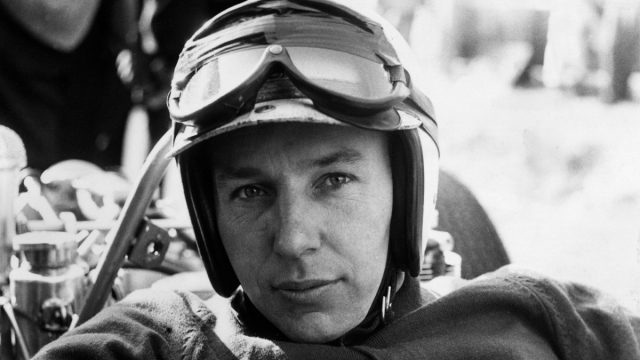
John Surtees made an immediate impact on four wheels with Team Lotus, scoring a second-place finish in the 1960 British GP at Silverstone, in only his second-ever Formula 1 race, and taking pole position at his third, the Portuguese GP in Lisbon. Lotus boss Colin Chapman urged him to join his team on a permanent basis as the team No.1 driver for 1961, but the straight-shooting John turned him down on the grounds that, as he later admitted, Chapman seemed “too devious by half”! Instead, he joined the private F1 Yeoman Credit Cooper team managed by Reg Parnell for the 1961 Formula 1 season, but this proved to be a mistake as the customer Cooper T53 was a long way from being as competitive as the works cars. An early-season non-championship race victory at Goodwood was thus John’s only win that year, albeit his first in a Formula 1 car. Nonetheless, Ferrari made an abortive approach for him to join them, while John was awarded the MBE for services to motorcycle racing in the Queen’s Birthday Honours list, upgraded to OBE in 2008, and CBE in 2016. Yet, astonishingly, he was never granted a knighthood, in spite of his enormous success both on bikes and in cars, and his substantial charity work later in life.
For the 1962 F1 season Surtees joined the Bowmaker Racing Team, still managed by Reg Parnell, but now driving a V8 Lola-Climax. But poor reliability and a weak chassis robbed him of any results until extra bracing resolved the problem, allowing John to end up fourth in the World Championship with two second-place GP finishes. Having served his F1 apprenticeship, he then agreed to join Scuderia Ferrari in 1963, initially experiencing mixed fortunes in the V6 Tipo 156 with five retirements, a second place at the British GP, victory in Germany – his first GP win on four wheels – and fastest laps at Monaco, Silverstone and the Nűrburgring. But in 1964 John Surtees duly won the F1 World Championship for the Italian team by a single point from BRM’s Graham Hill, previously champion in 1962, and father of future champion Damon, who also began his career on two wheels, albeit not at GP level like Surtees. John’s F1 title win came after two race victories at the Nűrburgring and Monza, plus three second places and one third in a closely fought season when little initially seemed to go right, and his Ferrari repeatedly suffered mechanical failure.
John’s Formula 1 World title victory was achieved despite the copious intrigue inseparable from going racing with Ferrari – for which his five years at MV Agusta had been good preparation! – not to mention the general disorganisation partly caused by perennial strikes in Italy, a lack of testing and the thin spreading of resources over both Formula 1 and sports car race programmes. At the British GP at Silverstone Surtees was obliged to put his workshop skills to good use as the only team member able to wield a welding torch, fabricating an auxiliary fuel tank that enabled his car to run the full race distance without stopping to refuel. Imagine Lewis Hamilton welding something up for his Mercedes F1 team today!
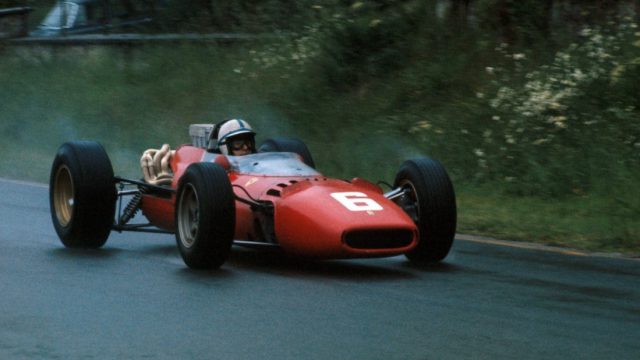
In 1965 John got permission from Enzo Ferrari to form Team Surtees to mount a CanAm sports car racing programme of his own in North America, to race there in between Formula 1 GP rounds. But after early success he suffered a major accident at Mosport in Canada that nearly killed him, when the suspension failed at high speed on the 5-litre V8 Lola T70 sports car he was racing, resulting in near-fatal injuries which after a lengthy recovery left him with one leg much shorter than the other. John’s comeback race the following spring saw him and Mike Parkes win the Monza 1000km in a Ferrari 330P3, but disagreements with Ferrari team manager Eugenio Dragoni over his physical health saw John walk out to join the much smaller Cooper-Maserati team. He won the season-ending Mexico GP for them to clinch second place in the World Championship, while in the Can-Am series he scored five wins in the Lola T70 to become champion.
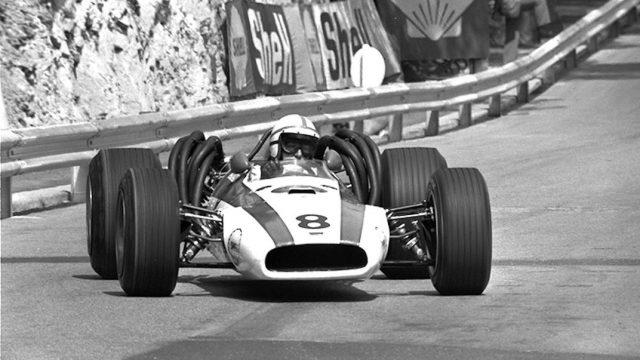
For 1967 John joined forces with Honda, though perhaps unfortunately for the Japanese firm not to help them defeat MV Agusta for the 500cc World Championship with their ill-handling RC181 four, ridden by Mike Hailwood. Instead, it was to develop and race their RA273 V12 Formula 1 car from his Team Surtees HQ in Edenbridge, Kent. But with the engine under-developed and the car overweight, John got permission from Soichiro Honda to develop a new British-built chassis with Lola, resulting in the lighter and more aerodynamic RA300 which Surtees himself drove to victory in its debut race at Monza – his last of six F1 GP victories in 111 starts – en route to fourth in the championship in Honda’s debut year. But with Team Surtees and Honda jointly on the verge of becoming a real championship contender with a smaller, all-new V12 engine, Honda cancelled the project without any consultation, and instead sent over a radical substitute, the air/oil cooled V8 RA302. John declared this “unfit to race” and “a potential deathtrap” without further development, and soldiered on with the RA301. Cruel luck deprived Surtees of almost certain wins in the Belgian and Italian GPs, in between which Honda independently entered the RA302 for the French GP at Rouen, with disastrous consequences. After two laps, the magnesium-bodied car inexplicably crashed and 58 laps' worth of fuel caught fire, killing local hero Jo Schlesser, its driver. At the end of the season Honda withdrew from Formula 1, after Surtees again refused to drive the car at the Italian GP at Monza.
After a troubled 1969 season in Formula 1 with BRM, John founded the Surtees Racing Organisation which competed as a constructor in Formula 1, Formula 2 and Formula 5000 from 1970 to 1978, starting with a GP car of his own design, the TS7 which he initially raced himself. But for 1971 Team Surtees signed John’s successor as Britain’s – and MV Agusta’s – two-wheeled superstar, Mike Hailwood, although despite strong finishes in non-championship races, a GP win evaded the team. The strain of development, testing, management and racing was taking its toll, leading John Surtees to retire from competitive driving in 1972. Hailwood took over as No.1 driver for Team Surtees, and convincingly won the European Formula 2 Championship in the Hart-engined Surtees TS10, to register the team’s greatest success. After a frequently troubled nine-year existence in the Formula 1 paddock, not helped by a perpetual funding crisis, Team Surtees was disbanded in 1978, without ever quite winning a Formula 1 GP.
Having renovated a lovely 16th century Tudor house near Lingfield, Surrey, John now turned to building up a property business, while devoting some time to motorsport consultancy, and to restoring many of the motorcycles and cars he’d collected or had on loan that were associated with his long career on both two and four wheels. He enjoyed demonstrating these and other Classic machines at numerous events all over the world, but especially at the annual Goodwood Festival of Speed, where he rode BMW motorcycles and drove Mercedes-Benz cars alongside Nortons and MV Agustas from his own stables, with equal aplomb.

Motorcycles remained his first love, though, and with the advent of Historic GP racing, John Surtees renewed his racing licence for what proved to be his final competitive event, the 1986 French Historic GP at Paul Ricard, run as a support race to the 500cc French GP. In that he finished third on his Manx Norton behind American Dave Roper and Kiwi former World champion Hugh Anderson, both on Matchless G50s, but after that decided to hang up his helmet for anything except tests and demos – though it didn’t stop him from sampling Wayne Gardner’s factory Honda NS500 two-stroke triple at Snetterton, and impressing Honda race engineers with his perceptive questions and grasp of detail after riding it.
John Surtees was married twice, first to Patricia Burke in 1962; the couple divorced in 1979. His second wife was Jane Sparrow, whom he married in 1987, and with whom he had three children, Leonora, Edwina and his only son, Henry, who followed his father into motor sport. Henry Surtees finished second in the 2008 Formula Renault UK Championship before he tragically died in a freak accident in the Formula 2 Championship race at Brands Hatch in July 2009, when a wheel from another car became detached in a crash and hit him on the head. He was just 18 years of age. His father John founded the Henry Surtees Foundation in his memory, to assist those with brain or head injuries.
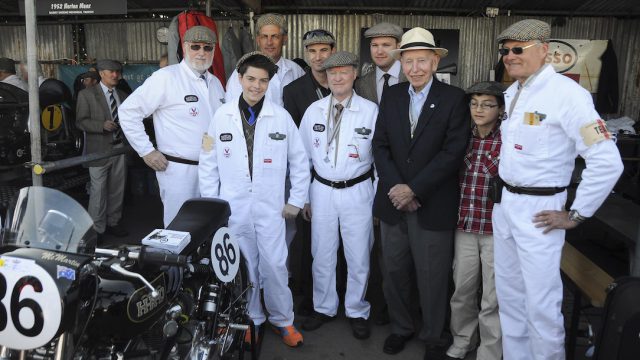
John Surtees was a hard but fair man who set high standards for himself and others which he expected them to adhere to. He absolutely knew his own mind, and wasn’t afraid of irking influential people, stubbornly sticking to his guns even if it meant ruffling feathers. If he’d been prepared to compromise or go back on his word on various occasions, he might have achieved even more than he did, especially in the murky world of the Formula 1 paddock where a straight-shooter like John was a fish out of water. He achieved a very great deal in life in spite of his humble origins, and both motorcycle and car worlds are very much the poorer for his leaving us.
* * * * *
